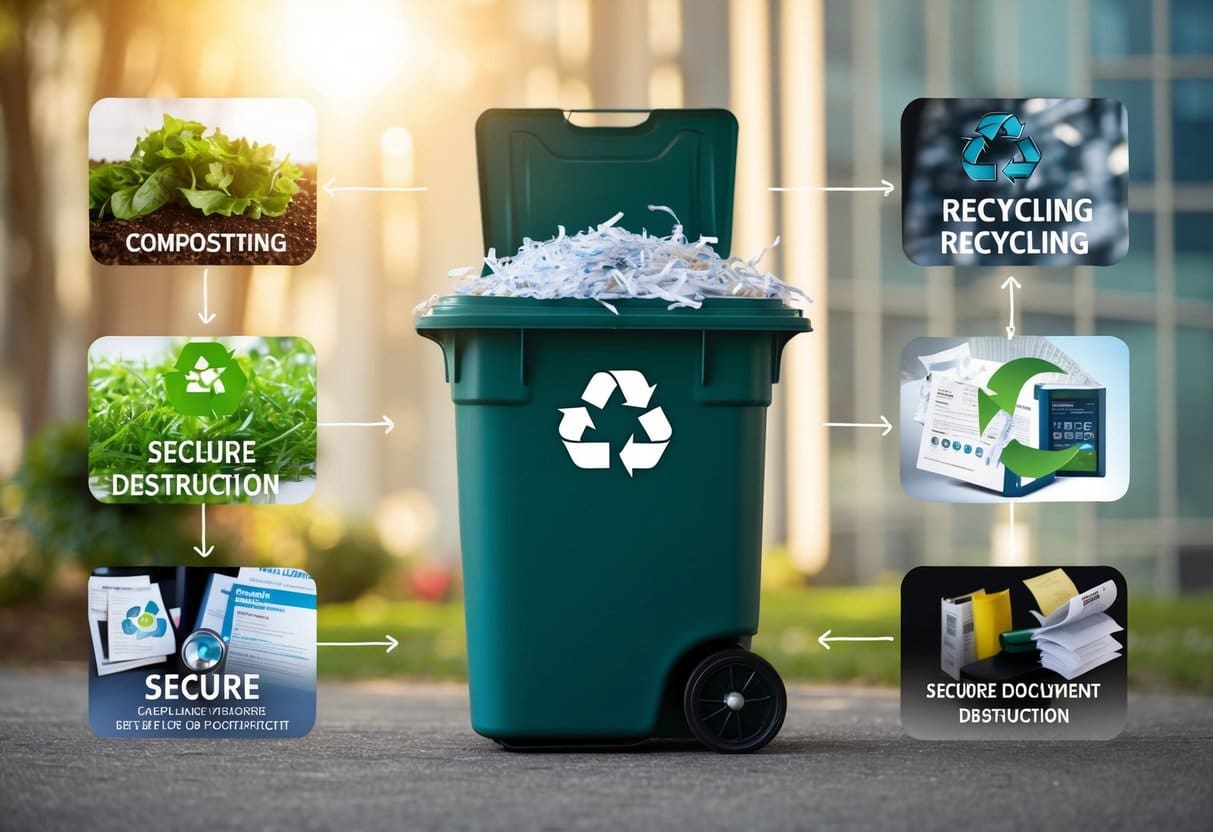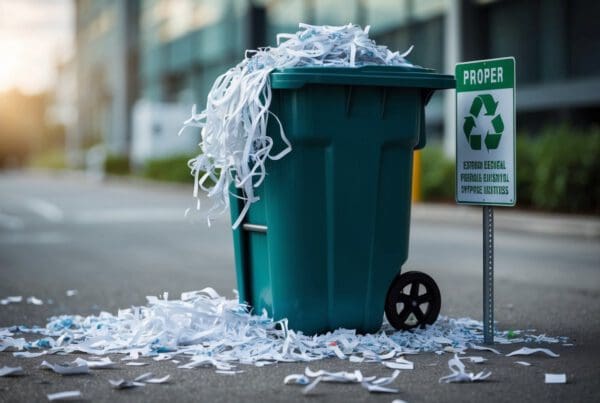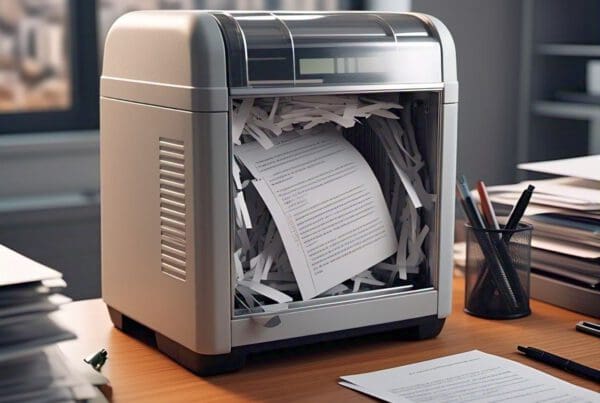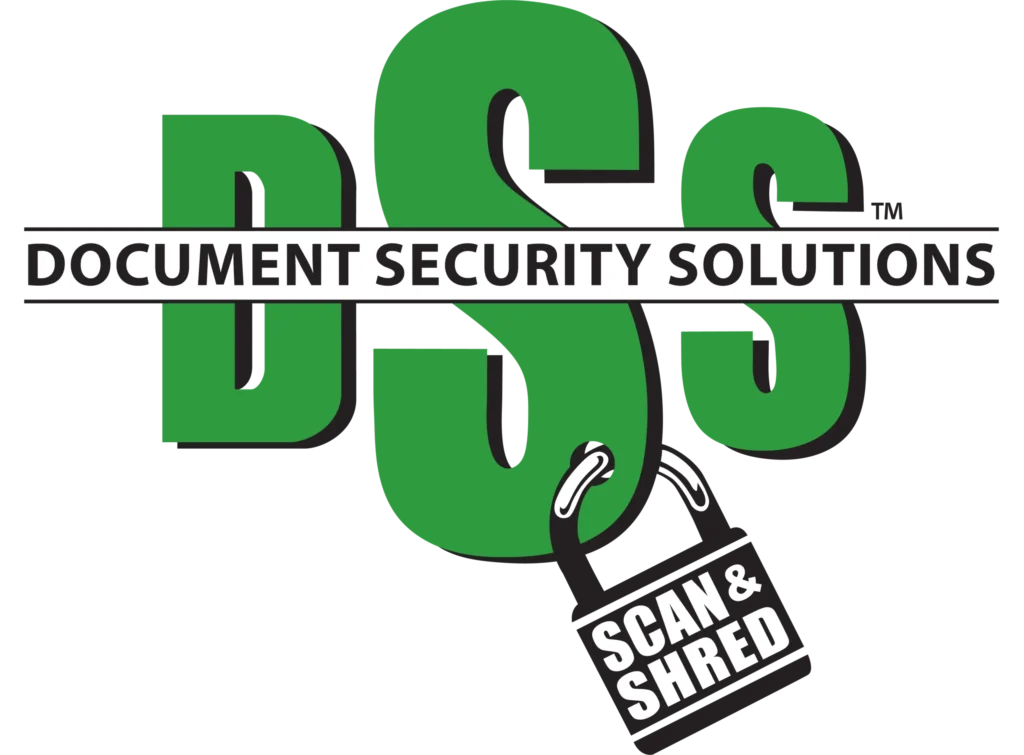Understanding Shredded Paper Disposal
When we dispose of shredded paper, it’s crucial to think about its impact on privacy and the environment. Proper handling prevents sensitive information from falling into the wrong hands and ensures that we dispose of paper waste responsibly.
The Lifecycle of Shredded Paper
Shredded paper’s lifecycle begins when it leaves our shredders. Each stage is essential. After shredding, we should collect the paper in bags or bins. It’s important that we keep it dry to maintain recyclable quality.
Recycling centers can process shredded paper, but it’s often kept separate due to its small size. This helps prevent clogging in machinery. Collecting it correctly enhances recyclability, ensuring shredded paper has the best chance of being recycled into new products.
Donations to animal shelters or farms can be another useful option. They often use it for bedding, providing shredded paper with a new purpose.
Risks of Improper Disposal
Improper disposal of shredded paper can lead to privacy risks. Leaving it unsecured exposes our sensitive information, like medical records or financial data, to theft. Identity theft is a severe consequence of carelessly discarded paper.
Environmental impact is another risk. When not recycled, shredded paper can end up in landfills, contributing to waste. Being cautious can help us reduce our carbon footprint and lessen waste.
By understanding these risks, we can act responsibly. Utilizing secure recycling or proper disposal methods not only protects our information but also supports sustainable practices.
Recycling Shredded Paper
We will explore how to recycle shredded paper by looking at recycling facilities’ guidelines and the recycling process itself. Proper disposal can help us make better environmental choices.
Recycling Facilities and Guidelines
Many local recycling centers accept shredded paper, yet not all facilities have the same rules. It’s important for us to check the guidelines of our local centers. Some places prefer shredded paper in clear plastic bags to separate it from other materials. This makes sorting easier.
In some cases, curbside recycling programs do not accept shredded paper. The small pieces can cause sorting machines to jam or mix with other recyclables, reducing their quality. As a result, we should try to transport it directly to a facility if curbside isn’t an option.
The Process of Recycling Shredded Paper
Recycling shredded paper involves several steps. Firstly, at the facility, shredded paper is usually combined and pressed into bales. Next, it gets mixed with water to create a slurry, and contaminants like staples are removed.
This slurry is then spread on screens to form new, thin sheets of paper. As it dries, a new paper product emerges. By completing these steps, we transform shredded paper into material for things like tissues or packaging, reducing waste and conserving resources.
Eco-Friendly Disposal Alternatives

Shredded paper can be managed in ways that are both eco-friendly and practical. We will discuss composting shredded paper and reusing it creatively for purposes like packing material or animal bedding. These methods help reduce waste and contribute to a more sustainable lifestyle.
Composting Shredded Paper
Using shredded paper in composting is a simple and effective way to dispose of it. Shredded paper is a carbon-rich material, also called “browns” in composting, that helps balance out the nitrogen-rich “greens” like food scraps and grass clippings.
When adding shredded paper to a compost pile, it’s important to mix it well. This ensures proper aeration and helps the compost break down efficiently. A good mix-in ratio for compost is approximately two-thirds browns to one-third greens.
The paper should also be free from inks or coatings that could harm the compost micro-environment. Always check to ensure the paper is not shiny or heavily processed to avoid introducing unwanted chemicals into the compost.
Creative Reuses for Shredded Paper
There are several creative ways to reuse shredded paper that keep it out of the landfill. One popular use is as packing material. Shredded paper can cushion fragile items during shipping or storage. It’s an eco-friendly alternative to plastic bubble wrap.
Another creative use is converting shredded paper into animal bedding. Small pets, like hamsters or guinea pigs, can find comfort in the softness of shredded paper.
It’s also possible to use shredded paper in craft projects. We can create unique art pieces or paper mache items that help express creativity and sustainability at the same time. Each reuse method supports our efforts to reduce waste and be more environmentally responsible.
Navigating Local Disposal Regulations
Knowing how to dispose of shredded paper correctly requires us to understand and follow local guidelines. It’s important to align with the rules to avoid contaminating the recycling stream.
Understanding Local Regulations
Local regulations can vary widely depending on where we live. Some areas may accept shredded paper in blue bins, while others might require it to be bagged separately or taken directly to a local recycling facility. It’s crucial to check with our city or town’s waste management department for specific guidelines.
In some places, shredded paper is not accepted because it can clog sorting machines and contaminate other recyclables. We should never assume shredded paper can be disposed of like regular paper. If local guidelines are unclear, reaching out for clarification ensures we follow the correct procedure.
Finding Your Local Recycling Service
Our first step is to identify who handles recycling in our area. We can often find the local recycling service contact information on the city or town’s official website. This service can inform us about correct disposal methods and any changes in their recycling policies.
Many local recycling services offer resources like drop-off locations or special pickup days for shredded paper. Some might even have convenient tools or mobile apps to check what materials are accepted in our recycling stream. By staying informed, we help preserve resources and keep our environment cleaner.
Best Practices for Shredding Documents
When shredding documents, choosing the right paper shredder and minimizing contamination are key. These steps ensure shredded paper is handled correctly and stays recyclable.
Selecting a Paper Shredder
Choosing the right paper shredder impacts efficiency and security. We should consider different types like strip-cut, cross-cut, and micro-cut.
- Strip-cut: Cuts sheets into long strips; it’s fast but less secure.
- Cross-cut: Shreds in small squares; offers better security.
- Micro-cut: Provides the highest security by turning sheets into tiny pieces.
We must also look at the shredder’s capacity. The sheet capacity tells us how many pages the shredder can handle at once without jamming. A high-capacity shredder saves time for big tasks.
Some shredders can handle staples and paper clips, while others can’t. Checking this prevents having to remove staples and clips beforehand.
Preventing Contamination
Contamination affects the recyclability of shredded paper. We should use designated paper bags instead of plastic bags to collect shredded paper. Most recycling centers won’t accept plastic, so paper bags keep it eco-friendly.
It’s essential to avoid mixing shredded paper with other waste. Mixing causes contamination, making the paper non-recyclable.
By keeping shredded and non-shredded paper separate, we ensure it can be properly processed. Shredded paper can generate dust, so storing it in a closed container until disposal helps maintain its cleanliness.





